Silk worm: Bombyx mori

Textiles / History of Silk
Sericulture or silk production has a long and colorful history unknown to most people. For centuries the West knew very little about silk and the people who made it. Pliny, the Roman historian, wrote in his Natural History in 70 BC "Silk was obtained by removing the down from the leaves with the help of water…". For more than two thousand years the Chinese kept the secret of silk altogether to themselves. It was the most zealously guarded secret in history.
ORIGIN OF SILK - LEGEND OF LADY HSI-LING-SHIH
Chinese legend gives the title Goddess of Silk to Lady Hsi-Ling-Shih, wife of the mythical Yellow Emperor, who was said to have ruled China in about 3000 BC. She is credited with the introduction of silkworm rearing and the invention of the loom. Half a silkworm cocoon unearthed in 1927 from the loess soil astride the Yellow River in Shanxi Province, in northern China, has been dated between 2600 and 2300 BC. Another example is a group of ribbons, threads and woven fragments, dated about 3000 BC, and found at Qianshanyang in Zhejiang province. More recent archeological finds - a small ivory cup carved with a silkworm design and thought to be between 6000 and 7000 years old, and spinning tools, silk thread and fabric fragments from sites along the lower Yangzi River – reveal the origins of sericulture to be even earlier.
SILKWORM AND THE FAMILY
There are many indigenous varieties of wild silk moths found in a number of different countries. The key to understanding the great mystery and magic of silk, and China's domination of its production and promotion, lies with one species: the blind, flightless moth, Bombyx mori. It lays 500 or more eggs in four to six days and dies soon after. The eggs are like pinpoints – one hundred of them weigh only one gram. From one ounce of eggs come about 30,000 worms which eat a ton of mulberry leaves and produce twelve pounds of raw silk. The original wild ancestor of this cultivated species is believed to be Bombyx mandarina Moore, a silk moth living on the white mulberry tree and unique to China. The silkworm of this particular moth produces a thread whose filament is smoother, finer and rounder than that of other silk moths. Over thousands of years, during which the Chinese practiced sericulture utilizing all the different types of silk moths known to them, Bombyx mori evolved into the specialized silk producer it is today; a moth which has lost its power to fly, only capable of mating and producing eggs for the next generation of silk producers.
THE SECRET OF SERICULTURE
Producing silk is a lengthy process and demands constant close attention. To produce high quality silk, there are two conditions which need to be fulfilled – preventing the moth from hatching out and perfecting the diet on which the silkworms should feed. Chinese developed secret ways for both.
* The eggs must be kept at 65 degrees F, increasing gradually to 77 degrees at which point they hatch. After the eggs hatch, the baby worms feed day and night every half hour on fresh, hand-picked and chopped mulberry leaves until they are very fat. Also a fixed temperature has to be maintained throughout. Thousands of feeding worms are kept on trays that are stacked one on top of another. A roomful of munching worms sounds like heavy rain falling on the roof. The newly hatched silkworm multiplies its weight 10,000 times within a month, changing color and shedding its whitish-gray skin several times.
*The silkworms feed until they have stored up enough energy to enter the cocoon stage. While they are growing they have to be protected from loud noises, drafts, strong smells such as those of fish and meat and even the odor of sweat. When it is time to build their cocoons, the worms produce a jelly-like substance in their silk glands, which hardens when it comes into contact with air. Silkworms spend three or four days spinning a cocoon around themselves until they look like puffy, white balls.
*After eight or nine days in a warm, dry place the cocoons are ready to be unwound. First they are steamed or baked to kill the worms, or pupas. The cocoons are then dipped into hot water to loosen the tightly woven filaments. These filaments are unwound onto a spool. Each cocoon is made up of a filament between 600 and 900 meters long! Between five and eight of these super-fine filaments are twisted together to make one thread.
*Finally the silk threads are woven into cloth or used for embroidery work. Clothes made from silk are not only beautiful and lightweight, they are also warm in cool weather and cool in hot weather.
Literary sources such as The Book of History, and The Book of Rites give further information about sericulture. Reeling silk and spinning were always considered household duties for women, while weaving and embroidery were carried out in workshops as well as the home. In every silk-producing province the daughters, mothers and grandmothers of every family devoted a large part of the day for six months in a year to the feeding, tending and supervision of silkworms and to the unraveling, spinning, weaving, dyeing and embroidering of silk. By the fifth century BC, at least six Chinese provinces were producing silk. Each spring, the empress herself inaugurated the silk-raising season, for silk production was the work of women all over China. The technique and process of sericulture were guarded secrets and closely controlled by Chinese authorities. Anyone who revealed the secrets or smuggled the silkworm eggs or cocoons outside of China would be punished by death.
SILK DEVELOPMENT IN CHINA
When silk was first discovered, it was reserved exclusively for the use of the ruler. It was permitted only to the emperor, his close relations and the very highest of his dignitaries. Within the palace, the emperor is believed to have worn a robe of white silk; outside, he, his principal wife, and the heir to the throne wore yellow, the color of the earth.
Gradually the various classes of society began wearing tunics of silk, and silk came into more general use. As well as being used for clothing and decoration, silk was quite quickly put to industrial use by the Chinese. This was something which happened in the West only in modern times. Silk, indeed, rapidly became one of the principal elements of the Chinese economy. Silk was used for musical instruments, fishing-lines, bowstrings, bonds of all kinds, and even rag paper, the word's first luxury paper. Eventually even the common people were able to wear garments of silk.
During the Han Dynasty, silk ceased to be a mere industrial material and became an absolute value in itself. Farmers paid their taxes in grain and silk. Silk began to be used for paying civil servants and rewarding subjects for outstanding services. Values were calculated in lengths of silk as they had been calculated in pounds of gold. Before long it was to become a currency used in trade with foreign countries. This use of silk continued during the Tang as well. It is possible that this added importance was the result of a major increase in production. It found its way so thoroughly into the Chinese language that 230 of the 5,000 most common characters of the mandarin "alphabet" have silk as their "key".
A SECRET OUT TO THE WORLD
In spite of their secrecy, however, the Chinese were destined to lose their monopoly on silk production. Sericulture reached Korea around 200 BC, when waves of Chinese immigrants arrived there. Silk reached the West through a number of different channels. Shortly after AD 300, sericulture traveled westward and the cultivation of the silkworm was established in India.
It is also said that in AD 440, a prince of Khotan ( today's Hetian)--a kingdom on the rim of Taklamakan desert -- courted and won a Chinese princess. The princess smuggled out silkworm eggs by hiding them in her voluminous hairpiece. This was scant solace to the silk-hungry people of the West, for Khotan kept the secret too. Why share it with the westerners and kill a good market?
Then around AD 550, two Nestorian monks appeared at the Byzantine Emperor Justinian's court with silkworm eggs hid in their hollow bamboo staves. Under their supervision the eggs hatched into worms, and the worms spun cocoons. Byzantium was in the silk business at last. The Byzantine church and state created imperial workshops, monopolizing production and keeping the secret to themselves. This allowed a silk industry to be established in the Middle East, undercutting the market for ordinary-grade Chinese silk. However high-quality silk textiles, woven in China especially for the Middle Eastern market, continued to bring high prices in the West, and trade along the Silk Road therefore continued as before. By the sixth century the Persians, too, had mastered the art of silk weaving, developing their own rich patterns and techniques. It was only in the 13th century—the time of the Second Crusades—that Italy began silk production with the introduction of 2000 skilled silk weavers from Constantinople. Eventually silk production became widespread in Europe.
SILK AND ITS TRADE
Silk became a precious commodity highly sought by other countries at a very early time, and it is believed that the silk trade was actually started before the Silk Road was officially opened in the second century BC. An Egyptian female mummy with silk has been discovered in the village of Deir el Medina near Thebes and the Valley of the Kings, dated 1070 BC, which is probably the earliest evidence of the silk trade. During the second century BC, the Chinese emperor, Han Wu Di's ambassadors traveled as far west as Persia and Mesopotamia, bearing gifts including silks. A Han embassy reached Baghdad in AD 97, and important finds of Han silks have been made along the Silk Road. One of the most dramatic finds of Tang silks along the Silk Road was made in 1907 by Aurel Stein. Some time around 1015, Buddhist monks, possibly alarmed by the threat of invasion by a Tibetan people, the Tanguts, sealed more than ten thousand manuscripts and silk paintings, silk banners, and textiles into a room at the Caves of the Thousand Buddhas near Dunhuang, a station on the Silk Road in north-west Gansu.
From about the fourth century BC, the Greeks and Romans began talking of Seres, the Kingdom of Silk. Some historians believe the first Romans to set eyes upon the fabulous fabric were the legions of Marcus Licinius Crassus, Governor of Syria. At the fateful battle of Carrhae near the Euphrates River in 53 BC, the soldiers were so startled by the bright silken banners of the Parthian troops that they fled in panic. Within decades Chinese silks became widely worn by the rich and noble families of Rome. The Roman Emperor Heliogabalus (AD 218 - 222) wore nothing but silk. By 380 AD, Marcellinus Ammianus reported, "The use of silk which was once confined to the nobility has now spread to all classes without distinction, even to the lowest." The craving of silk continued to increase over the centuries. The price of silk was very hight in Rome. The best Chinese bark ( a particular kind of silk) cost as much as 300 denarii (a Roman soldier's salary for an entire year!). Many sources quote that Roman citizens' demand for imported silks was so great as to be damaging to the Roman economy.
Silk was even beginning to have a civilizing effect on the barbarians. In 408 AD when Alaric, a Goth, besieged Rome, his price for sparing the city included 5000 pounds of gold, 3000 pounds of pepper, 30,000 pounds of silver and 4000 tunics of silk.
SILK TODAY
World silk production has approximately doubled during the last 30 years in spite of man-made fibers replacing silk for some uses. China and Japan during this period have been the two main producers, together manufacturing more than 50% of the world production each year. During the late 1970's China, the country that first developed sericulture thousands years ago dramatically increased its silk production and has again become the world's leading producer of silk.
ORIGIN OF SILK - LEGEND OF LADY HSI-LING-SHIH
Chinese legend gives the title Goddess of Silk to Lady Hsi-Ling-Shih, wife of the mythical Yellow Emperor, who was said to have ruled China in about 3000 BC. She is credited with the introduction of silkworm rearing and the invention of the loom. Half a silkworm cocoon unearthed in 1927 from the loess soil astride the Yellow River in Shanxi Province, in northern China, has been dated between 2600 and 2300 BC. Another example is a group of ribbons, threads and woven fragments, dated about 3000 BC, and found at Qianshanyang in Zhejiang province. More recent archeological finds - a small ivory cup carved with a silkworm design and thought to be between 6000 and 7000 years old, and spinning tools, silk thread and fabric fragments from sites along the lower Yangzi River – reveal the origins of sericulture to be even earlier.
SILKWORM AND THE FAMILY
There are many indigenous varieties of wild silk moths found in a number of different countries. The key to understanding the great mystery and magic of silk, and China's domination of its production and promotion, lies with one species: the blind, flightless moth, Bombyx mori. It lays 500 or more eggs in four to six days and dies soon after. The eggs are like pinpoints – one hundred of them weigh only one gram. From one ounce of eggs come about 30,000 worms which eat a ton of mulberry leaves and produce twelve pounds of raw silk. The original wild ancestor of this cultivated species is believed to be Bombyx mandarina Moore, a silk moth living on the white mulberry tree and unique to China. The silkworm of this particular moth produces a thread whose filament is smoother, finer and rounder than that of other silk moths. Over thousands of years, during which the Chinese practiced sericulture utilizing all the different types of silk moths known to them, Bombyx mori evolved into the specialized silk producer it is today; a moth which has lost its power to fly, only capable of mating and producing eggs for the next generation of silk producers.
THE SECRET OF SERICULTURE
Producing silk is a lengthy process and demands constant close attention. To produce high quality silk, there are two conditions which need to be fulfilled – preventing the moth from hatching out and perfecting the diet on which the silkworms should feed. Chinese developed secret ways for both.
* The eggs must be kept at 65 degrees F, increasing gradually to 77 degrees at which point they hatch. After the eggs hatch, the baby worms feed day and night every half hour on fresh, hand-picked and chopped mulberry leaves until they are very fat. Also a fixed temperature has to be maintained throughout. Thousands of feeding worms are kept on trays that are stacked one on top of another. A roomful of munching worms sounds like heavy rain falling on the roof. The newly hatched silkworm multiplies its weight 10,000 times within a month, changing color and shedding its whitish-gray skin several times.
*The silkworms feed until they have stored up enough energy to enter the cocoon stage. While they are growing they have to be protected from loud noises, drafts, strong smells such as those of fish and meat and even the odor of sweat. When it is time to build their cocoons, the worms produce a jelly-like substance in their silk glands, which hardens when it comes into contact with air. Silkworms spend three or four days spinning a cocoon around themselves until they look like puffy, white balls.
*After eight or nine days in a warm, dry place the cocoons are ready to be unwound. First they are steamed or baked to kill the worms, or pupas. The cocoons are then dipped into hot water to loosen the tightly woven filaments. These filaments are unwound onto a spool. Each cocoon is made up of a filament between 600 and 900 meters long! Between five and eight of these super-fine filaments are twisted together to make one thread.
*Finally the silk threads are woven into cloth or used for embroidery work. Clothes made from silk are not only beautiful and lightweight, they are also warm in cool weather and cool in hot weather.
Literary sources such as The Book of History, and The Book of Rites give further information about sericulture. Reeling silk and spinning were always considered household duties for women, while weaving and embroidery were carried out in workshops as well as the home. In every silk-producing province the daughters, mothers and grandmothers of every family devoted a large part of the day for six months in a year to the feeding, tending and supervision of silkworms and to the unraveling, spinning, weaving, dyeing and embroidering of silk. By the fifth century BC, at least six Chinese provinces were producing silk. Each spring, the empress herself inaugurated the silk-raising season, for silk production was the work of women all over China. The technique and process of sericulture were guarded secrets and closely controlled by Chinese authorities. Anyone who revealed the secrets or smuggled the silkworm eggs or cocoons outside of China would be punished by death.
SILK DEVELOPMENT IN CHINA
When silk was first discovered, it was reserved exclusively for the use of the ruler. It was permitted only to the emperor, his close relations and the very highest of his dignitaries. Within the palace, the emperor is believed to have worn a robe of white silk; outside, he, his principal wife, and the heir to the throne wore yellow, the color of the earth.
Gradually the various classes of society began wearing tunics of silk, and silk came into more general use. As well as being used for clothing and decoration, silk was quite quickly put to industrial use by the Chinese. This was something which happened in the West only in modern times. Silk, indeed, rapidly became one of the principal elements of the Chinese economy. Silk was used for musical instruments, fishing-lines, bowstrings, bonds of all kinds, and even rag paper, the word's first luxury paper. Eventually even the common people were able to wear garments of silk.
During the Han Dynasty, silk ceased to be a mere industrial material and became an absolute value in itself. Farmers paid their taxes in grain and silk. Silk began to be used for paying civil servants and rewarding subjects for outstanding services. Values were calculated in lengths of silk as they had been calculated in pounds of gold. Before long it was to become a currency used in trade with foreign countries. This use of silk continued during the Tang as well. It is possible that this added importance was the result of a major increase in production. It found its way so thoroughly into the Chinese language that 230 of the 5,000 most common characters of the mandarin "alphabet" have silk as their "key".
A SECRET OUT TO THE WORLD
In spite of their secrecy, however, the Chinese were destined to lose their monopoly on silk production. Sericulture reached Korea around 200 BC, when waves of Chinese immigrants arrived there. Silk reached the West through a number of different channels. Shortly after AD 300, sericulture traveled westward and the cultivation of the silkworm was established in India.
It is also said that in AD 440, a prince of Khotan ( today's Hetian)--a kingdom on the rim of Taklamakan desert -- courted and won a Chinese princess. The princess smuggled out silkworm eggs by hiding them in her voluminous hairpiece. This was scant solace to the silk-hungry people of the West, for Khotan kept the secret too. Why share it with the westerners and kill a good market?
Then around AD 550, two Nestorian monks appeared at the Byzantine Emperor Justinian's court with silkworm eggs hid in their hollow bamboo staves. Under their supervision the eggs hatched into worms, and the worms spun cocoons. Byzantium was in the silk business at last. The Byzantine church and state created imperial workshops, monopolizing production and keeping the secret to themselves. This allowed a silk industry to be established in the Middle East, undercutting the market for ordinary-grade Chinese silk. However high-quality silk textiles, woven in China especially for the Middle Eastern market, continued to bring high prices in the West, and trade along the Silk Road therefore continued as before. By the sixth century the Persians, too, had mastered the art of silk weaving, developing their own rich patterns and techniques. It was only in the 13th century—the time of the Second Crusades—that Italy began silk production with the introduction of 2000 skilled silk weavers from Constantinople. Eventually silk production became widespread in Europe.
SILK AND ITS TRADE
Silk became a precious commodity highly sought by other countries at a very early time, and it is believed that the silk trade was actually started before the Silk Road was officially opened in the second century BC. An Egyptian female mummy with silk has been discovered in the village of Deir el Medina near Thebes and the Valley of the Kings, dated 1070 BC, which is probably the earliest evidence of the silk trade. During the second century BC, the Chinese emperor, Han Wu Di's ambassadors traveled as far west as Persia and Mesopotamia, bearing gifts including silks. A Han embassy reached Baghdad in AD 97, and important finds of Han silks have been made along the Silk Road. One of the most dramatic finds of Tang silks along the Silk Road was made in 1907 by Aurel Stein. Some time around 1015, Buddhist monks, possibly alarmed by the threat of invasion by a Tibetan people, the Tanguts, sealed more than ten thousand manuscripts and silk paintings, silk banners, and textiles into a room at the Caves of the Thousand Buddhas near Dunhuang, a station on the Silk Road in north-west Gansu.
From about the fourth century BC, the Greeks and Romans began talking of Seres, the Kingdom of Silk. Some historians believe the first Romans to set eyes upon the fabulous fabric were the legions of Marcus Licinius Crassus, Governor of Syria. At the fateful battle of Carrhae near the Euphrates River in 53 BC, the soldiers were so startled by the bright silken banners of the Parthian troops that they fled in panic. Within decades Chinese silks became widely worn by the rich and noble families of Rome. The Roman Emperor Heliogabalus (AD 218 - 222) wore nothing but silk. By 380 AD, Marcellinus Ammianus reported, "The use of silk which was once confined to the nobility has now spread to all classes without distinction, even to the lowest." The craving of silk continued to increase over the centuries. The price of silk was very hight in Rome. The best Chinese bark ( a particular kind of silk) cost as much as 300 denarii (a Roman soldier's salary for an entire year!). Many sources quote that Roman citizens' demand for imported silks was so great as to be damaging to the Roman economy.
Silk was even beginning to have a civilizing effect on the barbarians. In 408 AD when Alaric, a Goth, besieged Rome, his price for sparing the city included 5000 pounds of gold, 3000 pounds of pepper, 30,000 pounds of silver and 4000 tunics of silk.
SILK TODAY
World silk production has approximately doubled during the last 30 years in spite of man-made fibers replacing silk for some uses. China and Japan during this period have been the two main producers, together manufacturing more than 50% of the world production each year. During the late 1970's China, the country that first developed sericulture thousands years ago dramatically increased its silk production and has again become the world's leading producer of silk.
Traditional Chinese Food
Most traditional Chinese food is closely associated with Chinese festival, and intends to honour either the god or divine persons in the history.
Jiao Zi 饺子 Traditional food for Chinese new year, the pronunciation imply meet at middle night on new years eve, also the shape of Chinese dumplings is similar to ancient Chinese gold ingots which symbolize wealth. On the Chinese New Year's Eve, a lucky coin is hidden in one of the dumplings, the person who finds the coin will likely have a good fortune in the New Year. You can make a variety of Chinese dumplings using different fillings based on your taste.
Jiao Zi 饺子 Traditional food for Chinese new year, the pronunciation imply meet at middle night on new years eve, also the shape of Chinese dumplings is similar to ancient Chinese gold ingots which symbolize wealth. On the Chinese New Year's Eve, a lucky coin is hidden in one of the dumplings, the person who finds the coin will likely have a good fortune in the New Year. You can make a variety of Chinese dumplings using different fillings based on your taste.
Zong Zi 粽子Traditional food for dragon boat festival and used to honour Qu Yuan (340-278 BC.), the pioneer poet of ancient China. It is glutinous rice filled with meat or beans wrapped in bamboo or reed leaves
Jiao Zi 饺子

Zong Zi 粽子Traditional food for dragon boat festival and used to honour Qu Yuan (340-278 BC.), the pioneer poet of ancient China. It is glutinous rice filled with meat or beans wrapped in bamboo or reed leaves
Zong Zi 粽子
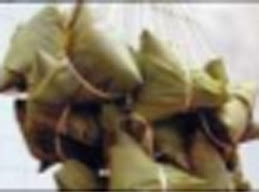
Yuan xiao 元宵
Yuan xiao are also known as "tang yuan," –tradional food for Lantern Festival, which is the fifteenth day on Chinese Lunar Calendar. It looks like balls and made of glutinous sticky rice, the filling can be sweet or salty. The small one are normally pink and white that submerged in sweet soup. Large ones contain sweet paste or salty filling inside such as black sesame paste, peanut powder, red beans, vegetables, or meat.
Tang yuan balls also represent family reunion since they are round in shape like the full moon.
Learn how to make Tang yuan.
Yuan xiao 元宵
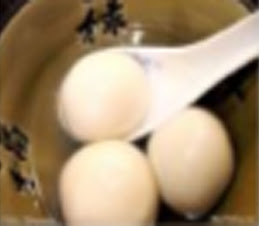
Mooncake 月饼
Mooncake is named after middle-autumn festival (also called Moon festival), which falls on the fifteenth day of the eighth month on Chinese lunar calendar, and Chinese believe it is the brightness night during the year. Mooncake is made of traditional pastry and filled with lotus seed paste, egg yolks, or red bean paste, black bean paste. It is quite rich for some people, usually served by pieces.
List most popular mooncake with their Chinese name:WHITE LOTUS SEED PASTE MOONCAKE (3 YOLKS)三黃白蓮蓉月餅LOTUS SEED PASTE MOONCAKE (2 YOLKS)雙黃蓮蓉月餅RED BEAN PASTE MOONCAKE (2 YOLKS)雙黃紅豆月餅GREEN BEAN PASTE MOONCAKE (2 YOLKS)雙黃豆蓉月餅OLIVE SEED RED DATE PASTE MOONCAKE欖仁紅棗蓉月餅HAM & ASSORTED NUTS MOONCAKE伍仁金華火腿月餅ASSORTED NUTS MOONCAKE純正伍仁月餅
Mooncake is named after middle-autumn festival (also called Moon festival), which falls on the fifteenth day of the eighth month on Chinese lunar calendar, and Chinese believe it is the brightness night during the year. Mooncake is made of traditional pastry and filled with lotus seed paste, egg yolks, or red bean paste, black bean paste. It is quite rich for some people, usually served by pieces.
List most popular mooncake with their Chinese name:WHITE LOTUS SEED PASTE MOONCAKE (3 YOLKS)三黃白蓮蓉月餅LOTUS SEED PASTE MOONCAKE (2 YOLKS)雙黃蓮蓉月餅RED BEAN PASTE MOONCAKE (2 YOLKS)雙黃紅豆月餅GREEN BEAN PASTE MOONCAKE (2 YOLKS)雙黃豆蓉月餅OLIVE SEED RED DATE PASTE MOONCAKE欖仁紅棗蓉月餅HAM & ASSORTED NUTS MOONCAKE伍仁金華火腿月餅ASSORTED NUTS MOONCAKE純正伍仁月餅
Mooncake 月饼

Nian gao 年糕Also known as rice cake, traditionally eaten at Chinese New Year, but people eat it all year round, it is made of glutinous rice. There are many different styles nian gao in China, for instance, shanghai style nian gao cooked in soup or package in a thick soft rod to be sliced up, Cantonese style nian gao is sweetened with brown sugar.
Nian gao 年糕
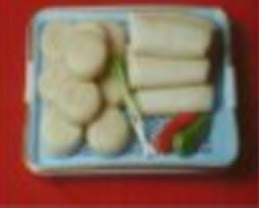
Baozi 包子
Also known as bun in the west. It is a type of steamed bread like food, and normally filled with meat or vegetable. It normally served as breakfast or starter for dinner. There are various type of bun depend on the shape, size and consistence, the most well known one is:Tianjin Guo bu li Bun (means Dogs Are Not Interested In), famous for it careful material selection and special techniques including mixing, stirring, rubbing and rolling etc.
Also known as bun in the west. It is a type of steamed bread like food, and normally filled with meat or vegetable. It normally served as breakfast or starter for dinner. There are various type of bun depend on the shape, size and consistence, the most well known one is:Tianjin Guo bu li Bun (means Dogs Are Not Interested In), famous for it careful material selection and special techniques including mixing, stirring, rubbing and rolling etc.
Baozi 包子

La mian拉面
A traditional Chinese hand-made noodles, usually served in a beef or mutton-flavoured soup or stir-fried. Generally speaking, noodle is more popular in Northern china. The majority of these lamian restaurants are owned by Hui ethnicity (who does not eat pork), the most famous La mian of all is come from Lan Zhou.
A traditional Chinese hand-made noodles, usually served in a beef or mutton-flavoured soup or stir-fried. Generally speaking, noodle is more popular in Northern china. The majority of these lamian restaurants are owned by Hui ethnicity (who does not eat pork), the most famous La mian of all is come from Lan Zhou.
La mian 拉面
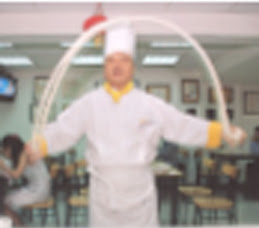
Wonton 餛飩Wonton is similar to dumpling but smaller, the main difference is made with a thin water pastry wrapper (made of wheat flour, water, salt) and filled with savory minced pork, shrimp etc. More popular in southern China.
Wonton 餛飩

Chinese Tea
The 10 Most famous Chinese teas
It's not straight forward. Different Chinese tea books and tea drinkers have different lists and THE 10 Most Famous Chinese Teas list doesn't seem to exist. The following Chinese teas are ranked by the frequency they appear on 20 lists from various references.
10 Wonders of the New China
It's a hotbed of innovative architecture, from diaphanous theaters to buildings heated and cooled by waterChina's current building boom is doing more than sucking up the world's supply of steel -- it's creating a stage for some of today's boldest architecture and engineering. Take a tour of the 10 of the most intriguing examples.
The Commune, Beijing

First phase completed 2002, expansion scheduled for completion in 2010
Even if the Commune didn't sit beside that wonder of the ancient world, the Great Wall of China, it would still qualify as a wonder. The complex includes houses by 12 of Asia's leading architects. It was conceived by married real-estate developers Zhang Xin and Pan Shiyi, who gave each architect a $1 million budget. Shigeru Ban, the Japanese architect most famous for the paper houses he designed for refugees of the Kobe earthquake, designed the Furniture House, featuring the laminated plywood typically used for modular furniture, and China's Yung Ho Chang created the Split House, which takes the idea of a boxy dwelling, slices it in half, and spreads it out like a fan. The Commune is now operated as a boutique hotel by the Germany luxury hotel group Kempinski, which is responsible for an upcoming expansion, which will feature 21 homes (including replications of the originals). One element will remain untouched in the new development: the Commune's private pedestrian trails, which trace untouched sections of the Great Wall.

Beijing International Airport, Beijing
According to the U.S. Embassy to China, the country will be building 108 new airports between 2004 and 2009 -- including what will be the world's largest: the Beijing International Airport, designed by Foster & Partners. Set to open at the end of 2007, in time for the Beijing Olympics in 2008, the airport terminal will cover more than 1 million square meters, giving it a bigger footprint than the Pentagon. It's designed to handle 43 million passengers a year initially and 55 million by 2015, figures that will probably push the new facility into the ranks of the top 10 busiest airports, going by the 2004 numbers from the Airports Council International. Given the scale and traffic, Foster & Partners focused on the traveler's experience, making sure that walking distances are short, for instance. Building on Foster's experience designing Hong Kong's new mega-airport, the massive Chek Lap Kok, the sprawling Beijing terminal is housed under a single roof. To help passengers distinguish between different sections of the vast space, skylights cast different shades of yellow and red light across walls -- a subtle but innovative navigational aid. The architects also kept sustainability in mind: An environmental-control system reduces carbon emissions, and skylights situated on a south-east axis lessen solar heat, keeping

Shanghai World Financial Center, Shanghai
Kohn Pedersen Fox Architects. Under construction, completion scheduled for 2008
Rising in the Lujiazhui financial district in Pudong, the Shanghai World Financial Center is a tower among towers. The elegant 101-story skyscraper will be (for a moment, at least) the world's tallest when completed in early 2008. One of the biggest challenges of building tall is creating a structure that can withstand high winds. The architects devised an innovation solution to alleviate wind pressure by adding a rectangular cut-out at the building's apex. Not only does the open area help reduce the building's sway but it also will be home to the world's highest outdoor observation deck -- a 100th-floor vista that will take vertigo to new heights.
Rising in the Lujiazhui financial district in Pudong, the Shanghai World Financial Center is a tower among towers. The elegant 101-story skyscraper will be (for a moment, at least) the world's tallest when completed in early 2008. One of the biggest challenges of building tall is creating a structure that can withstand high winds. The architects devised an innovation solution to alleviate wind pressure by adding a rectangular cut-out at the building's apex. Not only does the open area help reduce the building's sway but it also will be home to the world's highest outdoor observation deck -- a 100th-floor vista that will take vertigo to new heights.

National Swimming Center, Beijing
PTW and Ove Arup. Under construction, completion scheduled for 2008
The striking exterior of the National Swimming Center, being constructed for the 2008 Olympic Games and nicknamed, the "Water Cube," is made from panels of a lightweight form of Teflon that transforms the building into an energy-efficient greenhouse-like environment. Solar energy will also be used to heat the swimming pools, which are designed to reuse double-filtered, backwashed pool water that's usually dumped as waste.Excess rainwater will also be collected and stored in subterranean tanks and used to fill the pools. The complex engineering system of curvy steel frames that form the structure of the bubble-like skin are based on research into the structural properties of soap bubbles by two physicists at Dublin's Trinity College. The unique structure is designed to help the building withstand nearly any seismic disruptions.
The striking exterior of the National Swimming Center, being constructed for the 2008 Olympic Games and nicknamed, the "Water Cube," is made from panels of a lightweight form of Teflon that transforms the building into an energy-efficient greenhouse-like environment. Solar energy will also be used to heat the swimming pools, which are designed to reuse double-filtered, backwashed pool water that's usually dumped as waste.Excess rainwater will also be collected and stored in subterranean tanks and used to fill the pools. The complex engineering system of curvy steel frames that form the structure of the bubble-like skin are based on research into the structural properties of soap bubbles by two physicists at Dublin's Trinity College. The unique structure is designed to help the building withstand nearly any seismic disruptions.

Central Chinese Television CCTV, Beijing
OMA/Ole Scheeren and Rem Koolhaas. Under construction, scheduled for completion in 2008
The design of the new Central Chinese Television (CCTV) headquarters defies the popular conception of a skyscraper -- and it broke Beijing's building codes and required approval by a special review panel. The standard systems for engineering gravity and lateral loads in buildings didn't apply to the CCTV building, which is formed by two leaning towers, each bent 90 degrees at the top and bottom to form a continuous loop.The engineer's solution is to create a structural "tube" of diagonal supports. The irregular pattern of this "diagrid" system reflects the distribution of forces across the tube's surface. Designed by Rem Koolhaas and Ole Scheeren and engineered by Ove Arup, the new CCTV tower rethinks what a skyscraper can be.

Linked Hybrid, Beijing
Steven Holl Architects; Li Hu, lead architect. Groundbreaking on December 28, 2005, scheduled for completion in 2008
Linked Hybrid, which will house 2,500 people in 700 apartments covering 1.6 million square feet, is a model for large-scale sustainable residential architecture. The site will feature one of the world's largest geothermal cooling and heating systems, which will stabilize the temperature within the complex of eight buildings, all linked at the 20th floor by a "ring" of service establishments, like cafés and dry cleaners. A set of dual pipes pumps water from 100 meters below ground, circulating the liquid between the buildings' concrete floors. The result: The water-circulation system serves as a giant radiator in the winter and cooling system in the summer. It has no boilers to supply heat, no electric air conditioners to supply cool. The apartments also feature gray-water recycling -- a process that's just starting to catch on in Beijing in much smaller buildings -- to filter waste water from kitchen sinks and wash basins back into toilets.
Linked Hybrid, which will house 2,500 people in 700 apartments covering 1.6 million square feet, is a model for large-scale sustainable residential architecture. The site will feature one of the world's largest geothermal cooling and heating systems, which will stabilize the temperature within the complex of eight buildings, all linked at the 20th floor by a "ring" of service establishments, like cafés and dry cleaners. A set of dual pipes pumps water from 100 meters below ground, circulating the liquid between the buildings' concrete floors. The result: The water-circulation system serves as a giant radiator in the winter and cooling system in the summer. It has no boilers to supply heat, no electric air conditioners to supply cool. The apartments also feature gray-water recycling -- a process that's just starting to catch on in Beijing in much smaller buildings -- to filter waste water from kitchen sinks and wash basins back into toilets.

Dongtan Eco City, Dongtan
Masterplan by Arup, for the Shanghai Industrial Investment Corp. In planning stages, first phase to be completed in 2010
Developed by the Shanghai Industrial investment Corp., Dongtan Eco City, roughly the size of Manhattan, will be the world's first fully sustainable cosmopolis when completed in 2040. Like Manhattan, it's situated on an island -- the third-largest in China. Located on the Yangtze River, Dongtan is within close proximity of the bustle of Shanghai.By the time the Shanghai Expo trade fair opens in 2010, the city's first phase should be completed, and 50,000 residents will call Dongtan home-sweet-sustainable-home. The goals to be accomplished in the next five years: systems for water purification, waste management, and renewable energy. An infrastructure of roads will connect the former agricultural land with Shanghai.
Developed by the Shanghai Industrial investment Corp., Dongtan Eco City, roughly the size of Manhattan, will be the world's first fully sustainable cosmopolis when completed in 2040. Like Manhattan, it's situated on an island -- the third-largest in China. Located on the Yangtze River, Dongtan is within close proximity of the bustle of Shanghai.By the time the Shanghai Expo trade fair opens in 2010, the city's first phase should be completed, and 50,000 residents will call Dongtan home-sweet-sustainable-home. The goals to be accomplished in the next five years: systems for water purification, waste management, and renewable energy. An infrastructure of roads will connect the former agricultural land with Shanghai.

Olympic Stadium, Beijing
Herzog & de Meuron. Under construction, to be completed in 2008
Sports stadiums have long followed the enduring design of one of the original wonders of the world, Rome's Coliseum. Herzog & de Meuron's National Stadium in Beijing is an attempt to rethink the classic sports-arena layout for more ecologically correct times. The Swiss architects (of Tate Modern fame) wanted to provide natural ventilation for the 91,000-seat structure -- perhaps the largest "eco-friendly" sports stadium designed to date. To achieve this, they set out to create a building that could function without a strictly enclosed shell, yet also provide constant shelter for the audience and athletes alike. To solve these design problems, they looked to nature for inspiration. The stadium's outer grid resembles a bird's nest constructed of delicately placed branches and twigs. Each discrete space within the facility, from restrooms to restaurants, is constructed as an independent unit within the outer lattice -- making it possible to encase the entire complex with an open grid that allows for natural air circulation. The architects also incorporated a layer of translucent membrane to fill any gaps in the lacy exterior.
Sports stadiums have long followed the enduring design of one of the original wonders of the world, Rome's Coliseum. Herzog & de Meuron's National Stadium in Beijing is an attempt to rethink the classic sports-arena layout for more ecologically correct times. The Swiss architects (of Tate Modern fame) wanted to provide natural ventilation for the 91,000-seat structure -- perhaps the largest "eco-friendly" sports stadium designed to date. To achieve this, they set out to create a building that could function without a strictly enclosed shell, yet also provide constant shelter for the audience and athletes alike. To solve these design problems, they looked to nature for inspiration. The stadium's outer grid resembles a bird's nest constructed of delicately placed branches and twigs. Each discrete space within the facility, from restrooms to restaurants, is constructed as an independent unit within the outer lattice -- making it possible to encase the entire complex with an open grid that allows for natural air circulation. The architects also incorporated a layer of translucent membrane to fill any gaps in the lacy exterior.

Donghai Bridge, Shanghai/Yangshan Island
A key phase in the development of the world's largest deep-sea port was completed when China's first cross-sea bridge -- the 20-mile, six-lane Donghai Bridge -- was officially opened in December, 2005. Stretching across the East China Sea, the graceful cable-stay structure connects Shanghai to Yangshan Island, set to become China's first free-trade port (and the world's largest container port) upon its completion in 2010.

National Grand Theater, Beijing
Paul Andreu and ADP. Under construction, to be completed in 2008
Located near Tiananmen Square, the 490,485-square-foot glass-and-titanium National Grand Theater, scheduled to open in 2008, seems to float above a man-made lake. Intended to stand out amid the Chinese capital's bustling streets and ancient buildings, the structure has garnered criticism among Bejing's citizens for clashing with classic landmarks like the Monument to the People's Heroes (dedicated to revolutionary martyrs), the vast home of the National People's Congress, or Tiananmen Gate itself (the Gate of Heavenly Peace).French architect Paul Andreu is no stranger to controversy -- or to innovative forms. A generation ago, in 1974, his untraditional design for Terminal 1 of Paris's Charles de Gaulle airport was criticized for its unusual curves, yet Andreu's groundbreaking, futuristic building later was seen to distinguish de Gaulle from more generic European and international air hubs. (The same airport's Terminal 2E, also designed by Andreu, gained attention in 2004 when it collapsed, tragically killing four people.) Beijing's daring National Grand Theater is as much a spectacle as the productions that will be staged inside in the 2,416-seat opera house, the 2,017-seat concert hall, and the 1,040-seat theater. At night, the semi-transparent skin will give passersby a glimpse at the performance inside one of three auditoriums, a feature that highlights the building's public nature.
Located near Tiananmen Square, the 490,485-square-foot glass-and-titanium National Grand Theater, scheduled to open in 2008, seems to float above a man-made lake. Intended to stand out amid the Chinese capital's bustling streets and ancient buildings, the structure has garnered criticism among Bejing's citizens for clashing with classic landmarks like the Monument to the People's Heroes (dedicated to revolutionary martyrs), the vast home of the National People's Congress, or Tiananmen Gate itself (the Gate of Heavenly Peace).French architect Paul Andreu is no stranger to controversy -- or to innovative forms. A generation ago, in 1974, his untraditional design for Terminal 1 of Paris's Charles de Gaulle airport was criticized for its unusual curves, yet Andreu's groundbreaking, futuristic building later was seen to distinguish de Gaulle from more generic European and international air hubs. (The same airport's Terminal 2E, also designed by Andreu, gained attention in 2004 when it collapsed, tragically killing four people.) Beijing's daring National Grand Theater is as much a spectacle as the productions that will be staged inside in the 2,416-seat opera house, the 2,017-seat concert hall, and the 1,040-seat theater. At night, the semi-transparent skin will give passersby a glimpse at the performance inside one of three auditoriums, a feature that highlights the building's public nature.

Chinese contemporary designers
The open-door policy: experimentation with dressThe death of Mao Zedong on 9 September 1976 ended an era and led to the arrest of Mao's wife Jiang Qing and other members of the Gang of Four who rose to prominence during the Cultural Revolution.
The open-door policy and economic reforms which followed, created an environment in which people were receptive to the outside world and eager to make up for the 10 lost years of the Cultural Revolution. Dress was one of the first areas where attitudes were relaxed. Women began to wear coloured and patterned clothing, and accessories were emblazoned with English words such as 'happy' or 'beautiful' rather than 'serve the people'. Clothing which appeared foreign was perceived as modern.
The 1980s was a period of unprecedented experimentation with dress style. China's first fashion magazine Shizhuang (Fashion) was published in Peking in 1979. Since then such magazines have become popular reflecting the huge interest in personal appearance, beauty and consumer culture.
The open-door policy and economic reforms which followed, created an environment in which people were receptive to the outside world and eager to make up for the 10 lost years of the Cultural Revolution. Dress was one of the first areas where attitudes were relaxed. Women began to wear coloured and patterned clothing, and accessories were emblazoned with English words such as 'happy' or 'beautiful' rather than 'serve the people'. Clothing which appeared foreign was perceived as modern.
The 1980s was a period of unprecedented experimentation with dress style. China's first fashion magazine Shizhuang (Fashion) was published in Peking in 1979. Since then such magazines have become popular reflecting the huge interest in personal appearance, beauty and consumer culture.

Contemporary fashion:
Mainland China The contemporary fashion world in mainland China is vast, complex and there are many players. Most garments are produced by large state-run corporations and joint-venture companies established with overseas capital. Much design is therefore anonymous.
However, a growing number of designers have established their own labels and work independently. Many of them are young and entrepreneurial with a clearly identified market. They sell direct to customers or through up-market department stores.
Government agencies have played an active role in developing China's fashion industry. The China Garment Designers' Association has promoted the work of young designers since its inception in 1993. It organises fashion events such as the Golden Scissors Award for functional wear and the Japanese-sponsored Brother Cup for fashion designers under 35 which emphasises creativity over functionality. In 1996 the China Famous Brand Name Development Company was established to spearhead China's ambitions to create ten world-famous fashion labels by the year 2000.
Designers from mainland ChinaSun JianSun Jian (born 1967) taught fashion design for a number of years before being appointed chief designer of Aidekang (Ideal Couture Fashion Company Limited), a Beijing-based Chinese-German joint-venture, in 1989. In 1992 after working as chief designer for a number of other organisations Sun Jian established her own company and label, Sun Jian Fashion Studio. She has a growing clientele and her designs are worn by many young actors, pop stars and television personalities.
Sun Jian also has a popular image design business, advising clients on personal style, including hair, make-up, clothing and accessories. Clients often order two or three made-to-measure outfits. On average Sun Jian re-styles eight women per week.
However, a growing number of designers have established their own labels and work independently. Many of them are young and entrepreneurial with a clearly identified market. They sell direct to customers or through up-market department stores.
Government agencies have played an active role in developing China's fashion industry. The China Garment Designers' Association has promoted the work of young designers since its inception in 1993. It organises fashion events such as the Golden Scissors Award for functional wear and the Japanese-sponsored Brother Cup for fashion designers under 35 which emphasises creativity over functionality. In 1996 the China Famous Brand Name Development Company was established to spearhead China's ambitions to create ten world-famous fashion labels by the year 2000.
Designers from mainland ChinaSun JianSun Jian (born 1967) taught fashion design for a number of years before being appointed chief designer of Aidekang (Ideal Couture Fashion Company Limited), a Beijing-based Chinese-German joint-venture, in 1989. In 1992 after working as chief designer for a number of other organisations Sun Jian established her own company and label, Sun Jian Fashion Studio. She has a growing clientele and her designs are worn by many young actors, pop stars and television personalities.
Sun Jian also has a popular image design business, advising clients on personal style, including hair, make-up, clothing and accessories. Clients often order two or three made-to-measure outfits. On average Sun Jian re-styles eight women per week.
Sun Jian
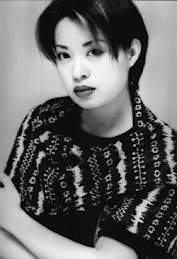
Tailored evening dress:
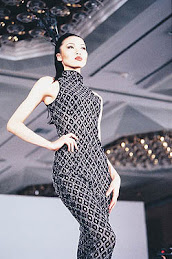
this cheungsam-inspired dress is made from a nylon-cotton knit ornamented with Austrian crystal diamantes. Photo by Li Xiaomu. Courtesy: Overseas Chinese News.
Trouser-suit
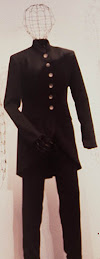
comprises a jacket with Chinese stand collar. The design of the jacket is inspired by an early form of the Sun Yat-sen suit. Photo by Duan Heping.
Guo Pei
Guo Pei (born 1967) worked for a number of fashion companies before becoming chief designer for the newly established Tianma (Heavenly Horse) Clothing Company, Peking, in 1989, which quickly became one of China's most popular womens labels. During Guo's six-year employment, 250 of her garments were produced, totalling some 400 000 items. In 1995 Guo Pei moved to the Milano Fashion Company Limited, a Taiwanese-American joint venture. While working with Milano, Guo Pei continued to design her own independent collections. In 1996 she resigned and established her own company Meiguifang (Mayflower) and in 1997 was named one of China's top ten designers.
Guo Pei
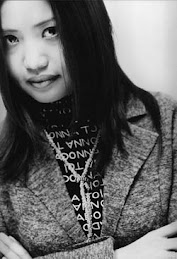
wollen
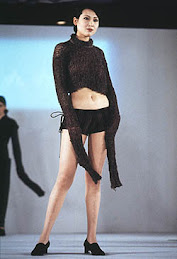
Woollen hipster shorts worn with a long-sleeved woollen jumper. Photo by Li Xiaomu. Courtesy: Overseas Chinese News.
Green hipster trousers
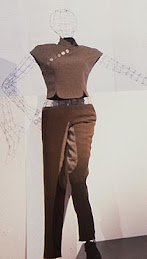
with a matching Chinese-style side-fastening top. Guo Pei has modified the traditional stand collar so that one side is turned down in a Western manner. Photo by Penelope Clay. Powerhouse Museum collection 2001/123/2
Mao's new suit
Mao's new suit, is an Australian documentary which charts the course of Peking fashion designers Sun Jian and Guo Pei staging a show during Shanghai's annual fashion week.
Both designers were born during the Cultural Revolution - a time when most women wore blue and grey trouser suits. To look fashionable was a sign of spiritual corruption and bourgeois tendencies. Today, armed with mobile phones and ambitious humour, they are a symbol of modern China's "to get rich is glorious" generation.
Contemporary fashion: Hong Kong The Western-style tailoring for which Hong Kong is renowned is linked to the territory's colonial past. British merchants established the basis for a textile industry soon after Hong Kong came under British rule in 1841.
The Hong Kong Trade Development Council was formed in 1966 to promote exports. As clothing and textiles were the major export, a core function of the council was to promote Hong Kong as an international fashion centre. By the 1970s it had become the manufacturing base for Levi Strauss jeans and many other famous international labels.
Today Hong Kong designers promote their collections at the biannual Hong Kong Fashion Week and at parades organised by the Hong Kong Fashion Designers' Association. It is through these high-fashion collections that designers seek to position themselves on the world stage. With the transition to Chinese sovereignty on 1 July 1997, Hong Kong has maintained its role as an important fashion centre. A number of designers used this historic event as a source of inspiration for their collections.
Designers from Hong KongPeter LauPeter Lau (born 1955) has worked in the fashion industry for over 20 years. In the mid-1970s he worked for knitwear and denim manufacturers and from 1975 to 1979 he studied textile technology at the Hong Kong Polytechnic. Lau established his own business in 1982 and in 1990 launched a label for special occasion wear, XCVIII Ninety-Eight. He has since launched a second label, China Doll, targeting teenagers. His primary markets are in Hong Kong, Taiwan and Japan.
Lau's garments have a playful, often raunchy interpretation of a Chinese folk aesthetic. Using vivid colours, patterns and textures many of his garments play on fantasies of the Oriental woman.
Both designers were born during the Cultural Revolution - a time when most women wore blue and grey trouser suits. To look fashionable was a sign of spiritual corruption and bourgeois tendencies. Today, armed with mobile phones and ambitious humour, they are a symbol of modern China's "to get rich is glorious" generation.
Contemporary fashion: Hong Kong The Western-style tailoring for which Hong Kong is renowned is linked to the territory's colonial past. British merchants established the basis for a textile industry soon after Hong Kong came under British rule in 1841.
The Hong Kong Trade Development Council was formed in 1966 to promote exports. As clothing and textiles were the major export, a core function of the council was to promote Hong Kong as an international fashion centre. By the 1970s it had become the manufacturing base for Levi Strauss jeans and many other famous international labels.
Today Hong Kong designers promote their collections at the biannual Hong Kong Fashion Week and at parades organised by the Hong Kong Fashion Designers' Association. It is through these high-fashion collections that designers seek to position themselves on the world stage. With the transition to Chinese sovereignty on 1 July 1997, Hong Kong has maintained its role as an important fashion centre. A number of designers used this historic event as a source of inspiration for their collections.
Designers from Hong KongPeter LauPeter Lau (born 1955) has worked in the fashion industry for over 20 years. In the mid-1970s he worked for knitwear and denim manufacturers and from 1975 to 1979 he studied textile technology at the Hong Kong Polytechnic. Lau established his own business in 1982 and in 1990 launched a label for special occasion wear, XCVIII Ninety-Eight. He has since launched a second label, China Doll, targeting teenagers. His primary markets are in Hong Kong, Taiwan and Japan.
Lau's garments have a playful, often raunchy interpretation of a Chinese folk aesthetic. Using vivid colours, patterns and textures many of his garments play on fantasies of the Oriental woman.
Peter Lau.

Neo-punk in China ensemble:
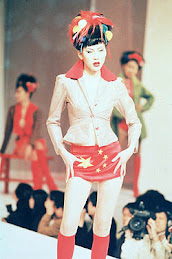
Comprising a paper nylon top with wool collar and a polyester satin skirt, screenprinted with a yellow star design evocative of the Chinese flag. Autumn-Winter 1996-97 collection. Photo by Anat Givon/AAP. 2002/21/1.
Winter under the Red Flag ensemble:

The cotton gaberdine trousers fasten at the inner leg and crotch. Autumn-Winter 1997-98 collection. Photo courtesy: Hong Kong Trade Development Council. Similar ensembles are held in the Powerhouse Museum collection. Gift of Peter Lau.
William Tang
In addition to designing clothes, William Tang (born 1959) is also a television presenter and writes for the press. He studied economics in Canada and fashion design at the London College of Fashion before returning to Hong Kong in 1982. He worked for a number of international labels before establishing his own company in 1985.
Tang has undertaken corporate-image and uniform design for clients such as Dragon Air and the new Hong Kong airport. His innovation and daring has earned him a reputation as an enfant terrible of the Hong Kong fashion world. Tang designs for men and women under the labels William Tang, W by William and the new teenage unisex label W10.
Tang has undertaken corporate-image and uniform design for clients such as Dragon Air and the new Hong Kong airport. His innovation and daring has earned him a reputation as an enfant terrible of the Hong Kong fashion world. Tang designs for men and women under the labels William Tang, W by William and the new teenage unisex label W10.
William Tang. Courtesy: William Tang
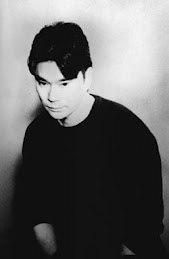
Womens ensemble:
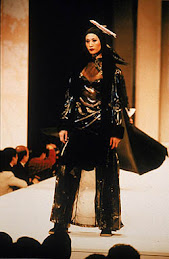
Comprising a Chinese-style top, trousers, and coat made of polyamide with fake fur shoulder bag and gauze cap ornamented with a recycled plastic toy aeroplane. Photo by Henry Ng. Courtesy: William Tang.
Friday, November 16, 2007
Subscribe to:
Comments (Atom)





